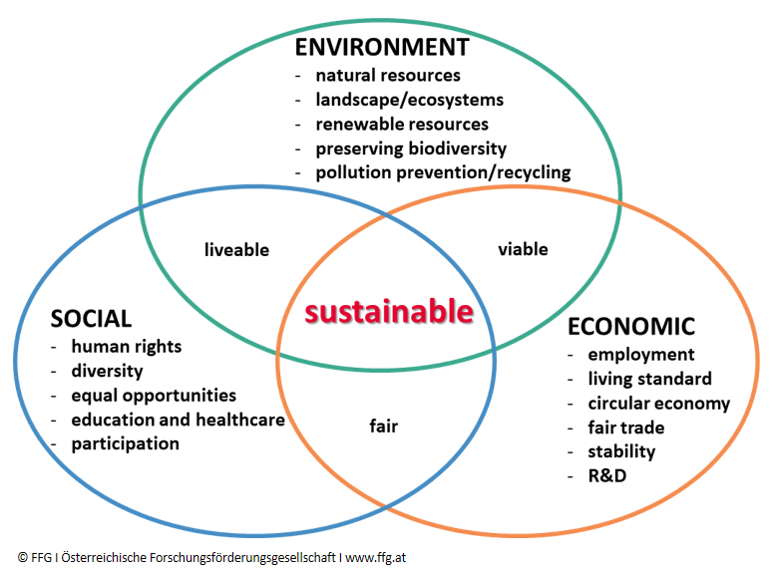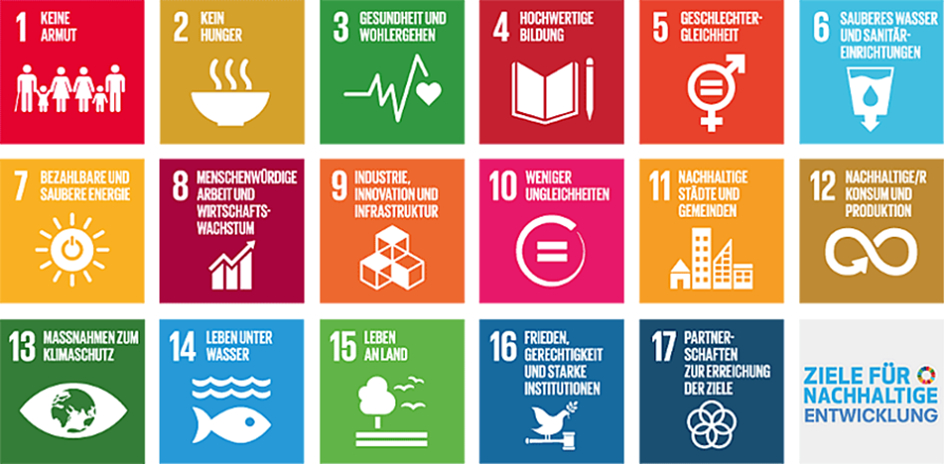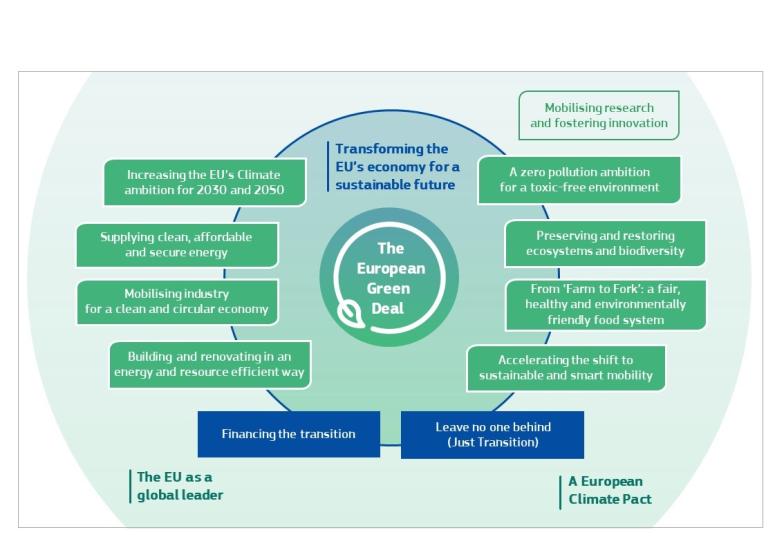Concise overview for applicants
- Sustainability in the FFG funding portfolio:
Since its establishment in 2004, the FFG has incorporated sustainability into its national open-topic and topic-specific funding programmes, focusing on concrete ecological, social and economic goals. More info - The sustainability criterion and the DNSH principle in the FFG selection procedures:
Assistance for applicants and evaluators within the FFG's selection procedures. More info - Information on the allocation of SDGs:
The 17 Sustainable Development Goals (SDGs) published by the United Nations in 2015 set clear targets and priorities. The European Green Deal is "the new growth strategy that aims to transform the EU into a fair and prosperous society, with a modern, resource-efficient and competitive economy." More info - Sustainability initiatives – national, European and global dimension:
Research funding by the FFG must align with the national objectives and the two underlying initiatives, the United Nations' 17 Sustainable Development Goals (SDGs) and the eight aspects of the EU Green Deal. More info
Sustainability in the FFG funding portfolio
Since its establishment in 2004, the FFG has incorporated sustainability into its national open-topic and topic-specific funding programmes, focusing on concrete ecological, social and economic goals.
Since 2021, the FFG has set extra priorities to more consistently pursue sustainability goals. This is done in collaboration with the owner ministries, the Federal Ministry for Climate Action, Environment, Energy, Mobility, Innovation and Technology (BMK), and the Federal Ministry of Labour and Economy (BMAW), as well as in cooperation with the Climate and Energy Fund, the National Foundation for Research, Technology and Development, the European Commission and the regional governments.
This means that projects with a clear positive sustainability impact are more likely to receive funding.
However, sustainability is multi-layered and complex, and in view of the global challenges, achieving the sustainability goals requires additional efforts and measures. The FFG supports companies and society in this transformation process. The development of sustainable products and production processes, innovative services and new business models as well as training and other measures to raise awareness can make a major contribution to achieving sustainability goals and significant sustainability impacts.
Sustainable research funding thus enhances social adaptation, decision-making and learning processes, which are crucial for businesses and science to initiate and integrate sustainable practices.
The sustainability criterion and the DNSH principle ("Do No Significant Harm") in the FFG selection procedures
What does this mean for applicants?
Since 2021, questions and criteria related to sustainability and climate neutrality have been incorporated into the FFG's funding formats. In the call guidelines, applicants can access specific information on objectives and requirements related to that call. The corresponding guidelines for the funding instruments offer a concise overview of the criteria underlying the selection process for research, technology, development and innovation projects.
Sustainability must be shown at the criteria level and is therefore an integral part of the selection process.
Applicants should note that sustainability is viewed with a focus on the project's ecological, social and economic impacts.
The application must demonstrate how the project contributes to ecological, social and economic sustainability goals and how sustainability considerations are integrated into the project's planning, implementation and exploitation.

Fig.: Three pillars of sustainability
Applicants must account for sustainability in research design and methodology, as well as system boundaries/system-relevant issues, to identify the project's potential positive impacts. A qualitative and quantitative evaluation of the positive impacts would be beneficial, assuming an adequate database is available. A comparison with the current state of knowledge, such as industry averages or alternative processes, can also aid in assessing sustainability impacts.
The Sustainable Development Goals (SDGs) of the UN serve as a guiding framework. Present only the essential aspects and their impact. How does the project address the sustainability goals? How are the sustainability goals achieved? How is success measured? Could your project potentially impact certain sustainability goals negatively?
| Examples of sustainability | Explanations |
| Ecology |
Ecological sustainability refers to the far-sighted and responsible use of natural resources. For example: Climate protection (air, water, soil, noise), resource consumption (circular economy, renewable resources, access to sustainable products for consumers, etc.), energy usage (reduction, clean energy, decarbonisation, efficiency improvements, etc.) |
| Social issues |
Social sustainability involves the intentional design of social and cultural systems. Maintaining the health (vitality, organisation and resilience) of these systems is of particular importance. This can be achieved by improving human capital, such as through education, and by strengthening social values and institutions, which significantly improve a social system's resilience. For example: Incorporating gender and/or diversity aspects into the solution approach (diverse user behaviours, physical and cultural differences, AI data bias, transparency of AI decisions, digital alternatives for the elderly, etc.), health challenges, educational concepts, methods, services and products that enhance inclusion, affordable services for sustainable urbanisation and mobility, frugal innovation, etc. |
| Economy |
Economic sustainability can be seen as the state of sustained economic prosperity. This assumes that the necessary resources to maintain a certain level of prosperity are accessible and that their quality remains stable or, ideally, improves. For example: Developing products and services to enhance occupational safety or improve working conditions, fair trade and partnerships with other companies, maximising economic returns while preserving essential input resources, etc. |
In the FFG's calls for proposals, applicants are asked to address negative displacement effects in their project in compliance with the "Do No Significant Harm" (DNSH) principle.
The "Do No Significant Harm" (DNSH) principle
The Commission's Communication on the European Green Deal [1] introduced the principle of "do no harm". The "Do No Significant Harm" (DNSH) principle was further elaborated in the EU Regulation on the establishment of a framework to facilitate sustainable investment [2], commonly known as the EU Taxonomy Regulation.
Article 9 of the EU Taxonomy Regulation lists six environmental objectives [3] and Article 17 defines what may be considered "doing significant harm" to these objectives:
The DNSH principle has also been applied in areas especially pertinent to the environmental outcomes and impacts of Horizon Europe, the world's largest transnational research programme.
Projects submitted must consider negative displacement effects. If the planned project is not anticipated to have explicitly positive impacts on or contribute to sustainability goals at any stage (research, benefits and exploitation, ex-post impact monitoring, etc.), applicants are asked to explain and describe this neutral status or impact.
Please note that projects with an overall (net) negative contribution/impact are given zero points in the sustainability sub-criterion.
Reviewers assess applications based on the sustainability criterion and compliance with the DNSH principle.
Applicants may refer to the DNSH principle when outlining their research methodology and the anticipated impact of the project to demonstrate that it will not significantly harm any of the following six environmental objectives outlined in the EU Taxonomy Regulation.
- An economic activity is considered to significantly harm climate change mitigation, where that activity leads to significant greenhouse gas emissions (GHG);
- An economic activity is considered to significantly harm climate change adaptation, where that activity leads to an increased adverse impact of the current climate and the expected future climate, on the activity itself or on people, nature or assets;
- An economic activity is considered to significantly harm the sustainable use and protection of water and marine resources, where that activity is detrimental to the good status or the good ecological potential of bodies of water, including surface water and groundwater; or to the good environmental status of marine waters;
- An economic activity is considered to significantly harm the circular economy, including waste prevention and recycling, where that activity leads to significant inefficiencies in the use of materials or in the direct or indirect use of natural resources, or leads to a significant increase in the generation, incineration or disposal of waste, or where the long-term disposal of waste may cause significant and long-term harm to the environment;
- An economic activity is assumed to significantly harm pollution prevention and control, where that activity leads to a significant increase in the emissions of pollutants into air, water or land;
- An economic activity is assumed to significantly harm the protection and restoration of biodiversity and ecosystems, where that activity is significantly detrimental to the good condition and resilience of ecosystems; or detrimental to the conservation status of habitats and species, including those of Union interest.
[1] COM (2019) 640, The European Green Deal.
[2] The EU Taxonomy Regulation refers to Regulation (EU) 2020/852 on the establishment of a framework to facilitate sustainable investment by establishing a classification system (or taxonomy) for environmentally sustainable economic activities.
[3] Climate change mitigation; climate change adaptation; the sustainable use and protection of water and marine resources; the transition to a circular economy; pollution prevention and control; the protection and restoration of biodiversity and ecosystems.
Information on the allocation of SDGs:
The 17 Sustainable Development Goals (SDGs) published by the United Nations in 2015 set clear targets and priorities. Sub-goals were formulated for each goal.
The 17 Sustainable Development Goals (SDGs)

Projects submitted to the FFG are evaluated to assess their contribution to one or more SDGs. This approach aids in statistically monitoring the alignment of submitted projects with the Sustainable Development Goals and in initially allocating the application to specific sustainability goals addressed by the project.
Applicants are therefore required to assign their project to sustainability goals in the eCall system. The recommendation is to limit assignments to a maximum of three goals, identifying them as either a "central goal" or a "secondary goal." If the project does not contribute to any SDG, "No option applicable" can be ticked.
If your project contributes to climate protection, please select SDG 13, "Climate Action". Examples include mitigating climate change, adapting to its impacts and enhancing understanding of its causes.
All additional sustainability considerations are integral to project planning, covering impacts both within the project and from the use of its results. See also –
Assistance for companies:
The SDG Compass explains how the SDGs impact your company. It provides tools and information to help you integrate sustainability in your business strategy.
Sustainability initiatives – national, European and global dimension
Research funding by the FFG must align with the national objectives and the two underlying initiatives, the United Nations' 17 Sustainable Development Goals (SDGs) and the eight aspects of the EU Green Deal.
The Austrian Federal Government declared, "Together we can reach the goal of a climate-neutral Austria by 2040 at the latest and can play a pioneering role in climate protection in Europe." (Out of a Sense of Responsibility for Austria. Government Programme 2020-2024, p. 102), emphasising sustainability and climate neutrality as key priorities in its 2020 Government Programme.
The national targets align with the 2030 Agenda, where the United Nations adopted 17 Sustainable Development Goals in 2015, commitments also undertaken by Austria. The specific and actionable sub-goals of the Sustainable Development Goals (SDGs) (only available in German) relevant to Austria are listed on the website of the Federal Chancellery.
In 2019, the European Commission published the European Green Deal, a strategy aimed at making Europe the first climate-neutral continent by 2050.
The European Green Deal is "the new growth strategy that aims to transform the EU into a fair and prosperous society, with a modern, resource-efficient and competitive economy where there are no net emissions of greenhouse gases in 2050 and where economic growth is decoupled from resource use."
The Green Deal includes various aims and initiatives, as shown in the following illustration:

The EU wants to be climate-neutral by 2050. To legally bind this political commitment and stimulate investments, the European Commission has proposed a European Climate Law.
To reach this goal, every sector of our economy must take action, including decarbonising the energy sector, renovating buildings, fostering industry innovation and promoting eco-friendly mobility.
New technologies, sustainable solutions and breakthrough innovations are key to achieving the Green Deal goals. This challenge exceeds the capabilities of individual member states. In collaboration with other EU programmes, the Horizon Europe (HEU) programme will be pivotal in mobilising national public and private investments. The Green Deal provides clear directionality to R&D funding.
